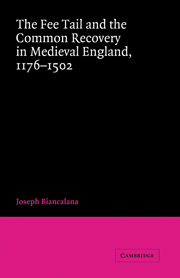Book contents
- Frontmatter
- Contents
- Acknowledgments
- List of abbreviations and abbreviated citations
- Introduction
- 1 Fee tails before De Donis
- 2 The growth of the “perpetual” entail
- 3 Living with entails
- 4 Barring the enforcement entails other than by common recovery
- 5 The origin and development of the common recovery
- 6 The common recovery in operation
- Appendix to Chapter 6
- Bibliography
- Subject and selected persons index
- Index to persons and places in Appendix to Chapter 6
6 - The common recovery in operation
Published online by Cambridge University Press: 28 July 2009
- Frontmatter
- Contents
- Acknowledgments
- List of abbreviations and abbreviated citations
- Introduction
- 1 Fee tails before De Donis
- 2 The growth of the “perpetual” entail
- 3 Living with entails
- 4 Barring the enforcement entails other than by common recovery
- 5 The origin and development of the common recovery
- 6 The common recovery in operation
- Appendix to Chapter 6
- Bibliography
- Subject and selected persons index
- Index to persons and places in Appendix to Chapter 6
Summary
The invention of the common recovery in 1440 and the increasing use of recoveries thereafter pose three questions. First, in what types of land transactions did the parties use a recovery? Secondly, in these transactions what role did the recovery play? These questions are addressed in the first part of this chapter. And thirdly, what were the social attitudes toward using a recovery? This question is addressed in the second part of this chapter.
THE USES OF RECOVERIES
Understanding in what types of transactions the parties used a recovery requires that contexts be constructed for recoveries found on the plea rolls. In the period 1440 through 1502, the total number of transactions effected by means, in part, of a recovery is not known. Out of a sample of 1,169 transactions using recoveries in this period, contexts have been constructed for 334 transactions. The 334 transactions are calendared in the Appendix to this chapter. All counties but four (Cheshire, Lancaster, Northumberland, and Westmorland) are represented in the sample. Transactions were classified into four main types: sales of land, transfers into mortmain, dispute settlements, and resettlements. The calendar of the 334 transactions in the Appendix gives reasons why a transaction was put in its category.
- Type
- Chapter
- Information
- The Fee Tail and the Common Recovery in Medieval England1176–1502, pp. 313 - 351Publisher: Cambridge University PressPrint publication year: 2001



